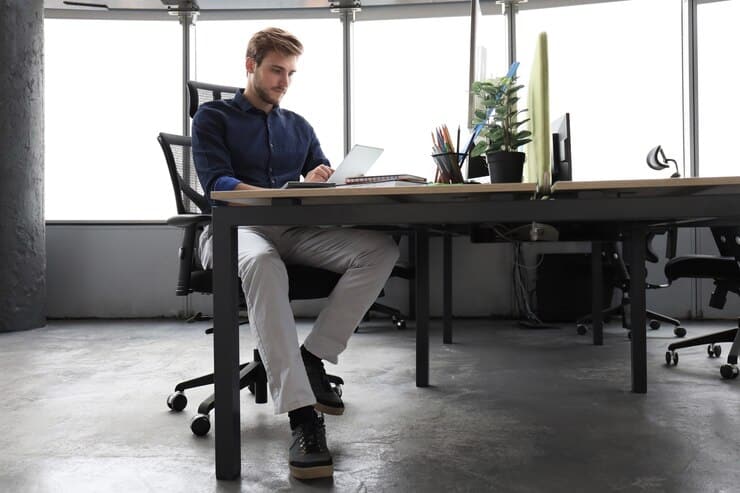Innovations in the modern workplace have made our jobs easier, more efficient, and more productive. Yet, the physical discomfort that often accompanies long hours at a desk or leaning into a computer screen is a persistent issue that many of us face. This discomfort can manifest in various forms, such as back pain, neck strain, and headaches, which can significantly affect productivity and quality of life.
Ergonomics, the study of people’s efficiency in their working environment, offers a solution to this prevalent problem. It focuses on designing workspaces that meet the unique needs of each individual, promoting comfort, efficiency, and health. The principles of ergonomics can be applied to any workspace, whether it’s a bustling office or a quiet home study.
Incorporating ergonomics into your workspace can seem like a daunting task, but it doesn’t have to be. Simple changes can make a significant impact. It could be as straightforward as adjusting the position of your computer screen, investing in an ergonomic chair, or taking regular breaks to stretch and move around. So, let’s delve into the world of ergonomics and uncover the secrets to a pain-free workspace.
Tip #1: Optimize Your Desk Setup
An ergonomic desk setup is a crucial starting point for establishing a comfortable workspace. Ensure your monitor, keyboard, mouse, and other essential items are positioned correctly to minimize strain on your back, neck, and shoulders. Consider the following tips to optimize your work environment:
- Monitor placement: Position your computer monitor directly in front of you at eye level, about 20-30 inches from your face. This placement reduces strain on your neck muscles, preventing discomfort and potential headaches.
- Desk height: Your desk should be high enough to allow your forearms to rest comfortably on the surface while typing, with your elbows bent at a 90-degree angle. This posture minimizes stress on your wrists and shoulders.
- Desk organization: Keeping frequently used items within easy reach reduces unnecessary reaching and twisting motions. Remember to maintain a clutter-free workspace, allowing sufficient room for your keyboard, mouse, and other essential tools.
Tip #2: Choose a Supportive Chair
A high-quality ergonomic chair is one of the most critical components of a pain-free workspace. Invest in a chair with proper lumbar support to maintain the natural curvature of your spine while seated. Look for the following features when choosing an ergonomic chair:
- Adjustable seat height: The height of your chair should allow your feet to rest flat on the floor with your knees bent at a comfortable 90-degree angle.
- Lumbar support: A chair with built-in lumbar support or a separate cushion can provide much-needed support for your lower back, reducing the risk of developing pain and discomfort.
- Armrests: Adjustable armrests that support your forearms while typing can help alleviate fatigue and pressure on your wrists and fingers.
- Seat material: Opt for a chair with breathable, cushioned fabric to maintain comfort throughout the day.
Tip #3: Implement Proper Keyboard and Mouse Usage
The repetitive use of a keyboard and mouse can lead to strain on your wrists, arms, and shoulders, contributing to pain and discomfort. Apply the following ergonomic principles to ensure healthy keyboard and mouse usage:
- Keyboard position: Place your keyboard directly in front of you, allowing your arms to remain close to your body and your wrists in a neutral position.
- Wrist support: An ergonomic wrist rest can help maintain proper wrist alignment and reduce stress on your hands and fingers.
- Mouse selection: Choose an ergonomic mouse that fits comfortably in your hand and is easily maneuverable without requiring excessive movements.
- Shortcuts and breaks: Make use of keyboard shortcuts to minimize repetitive motions. Schedule regular breaks to rest your hands and perform gentle stretches throughout the workday.
Tip #4: Incorporate Movement and Stretching Breaks
Prolonged sitting in any position can result in unwanted aches and pains. Incorporate regular movement and stretching breaks throughout your day to help maintain flexibility, reduce muscle tension, and minimize pain. Consider these simple strategies to stay active while working:
- Take frequent breaks: Stand up and stretch every 30 minutes to an hour. Set a timer or use an app to remind you when it’s time to take a break.
- Exercise during breaks: Engage in light exercises like walking around the office or performing simple stretches to encourage circulation and relieve tense muscles.
- Explore alternative workstations: Consider options such as a standing desk or an active sitting chair to engage your core muscles and maintain an upright posture during the workday.
- Post-work decompression: Participate in activities like yoga, swimming, or light jogging after work to release tension and maintain overall well-being.
Creating a Pain-Free Workspace: A Lasting Investment in Health and Productivity
Ergonomics isn’t merely about acquiring the latest adjustable chair or standing desk; it is about creating a workspace environment that synchronizes with your body’s needs and movements. It involves understanding the interaction between different elements of the system, such as the individual, the job, and the equipment used, and then making necessary adjustments to ensure a safe and comfortable working experience.
At Forza Chiropractic, our team of specialists is dedicated to helping you maintain optimal spinal health and prevent work-related pain. We offer a range of treatment options, including chiropractic adjustments, physical therapy, and valuable ergonomic advice to ensure your workspace is tailored to support your well-being.
Don’t let workspace-related pain hold you back—reach out to our chiropractic clinic in Arlington Heights today to schedule a consultation and start your journey towards a healthier and more productive work experience.

